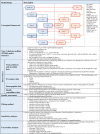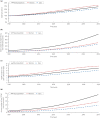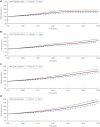Forecasting the type 2 diabetes mellitus epidemic and the role of key risk factors in Oman up to 2050: Mathematical modeling analyses
- PMID: 33112504
- PMCID: PMC8264408
- DOI: 10.1111/jdi.13452
Forecasting the type 2 diabetes mellitus epidemic and the role of key risk factors in Oman up to 2050: Mathematical modeling analyses
Abstract
Aims/introduction: To investigate and forecast type 2 diabetes mellitus epidemic, its related risk factors and cost in Oman by 2050.
Materials and methods: An age-structured mathematical model was used to characterize type 2 diabetes mellitus epidemiology and trends in Oman between 1990 and 2050. The model was parametrized using current and quality data, including six nationally representative population-based epidemiological surveys for type 2 diabetes mellitus and its key risk factors.
Results: The projected type 2 diabetes mellitus prevalence increased from 15.2% in 2020 to 23.8% in 2050. The prevalence increased from 16.8 and 13.8% in 2020 among women and men to 26.3 and 21.4% in 2050, respectively. In 2020, 190,489 Omanis were living with type 2 diabetes mellitus compared with 570,227 in 2050. The incidence rate per 1,000 person-years changed from 8.3 in 2020 to 12.1 in 2050. Type 2 diabetes mellitus' share of Oman's national health expenditure grew by 36% between 2020 and 2050 (from 21.2 to 28.8%). Obesity explained 56.7% of type 2 diabetes mellitus cases in 2020 and 71.4% in 2050, physical inactivity explained 4.3% in 2020 and 2.7% in 2050, whereas smoking accounted for <1% of type 2 diabetes mellitus cases throughout 2020-2050. Sensitivity and uncertainty analyses affirmed these predictions.
Conclusions: The type 2 diabetes mellitus epidemic in Oman is expected to increase significantly over the next three decades, consuming nearly one-third of the national health expenditure. The type 2 diabetes mellitus burden is heavily influenced by obesity. Interventions targeting this single risk factor should be a national priority to reduce and control the burden of type 2 diabetes mellitus in Oman.
Keywords: Forecasting model; Non-communicable disease; Risk factor.
© 2020 The Authors. Journal of Diabetes Investigation published by Asian Association for the Study of Diabetes (AASD) and John Wiley & Sons Australia, Ltd.
Conflict of interest statement
The authors declare no conflict of interest.
Figures





Similar articles
-
Impact of mitigating obesity, smoking, and physical inactivity on type 2 diabetes mellitus burden in Oman: insights from mathematical modeling.BMJ Open Diabetes Res Care. 2024 Aug 3;12(4):e004248. doi: 10.1136/bmjdrc-2024-004248. BMJ Open Diabetes Res Care. 2024. PMID: 39097298
-
Type 2 diabetes in the sultanate of Oman.Malays J Nutr. 2011 Apr;17(1):129-41. Malays J Nutr. 2011. PMID: 22135872 Review.
-
Forecasting the burden of type 2 diabetes mellitus in Qatar to 2050: A novel modeling approach.Diabetes Res Clin Pract. 2018 Mar;137:100-108. doi: 10.1016/j.diabres.2017.11.015. Epub 2017 Nov 22. Diabetes Res Clin Pract. 2018. PMID: 29175341
-
Characterizing the type 2 diabetes mellitus epidemic in Jordan up to 2050.Sci Rep. 2020 Dec 3;10(1):21001. doi: 10.1038/s41598-020-77970-7. Sci Rep. 2020. PMID: 33273500 Free PMC article.
-
Analytical Data Review to Determine the Factors Impacting Risk of Diabetes in North Al-Batinah Region, Oman.Int J Environ Res Public Health. 2021 May 17;18(10):5323. doi: 10.3390/ijerph18105323. Int J Environ Res Public Health. 2021. PMID: 34067749 Free PMC article. Review.
Cited by
-
A systematic review of interventions to promote physical activity in six Gulf countries.PLoS One. 2021 Oct 28;16(10):e0259058. doi: 10.1371/journal.pone.0259058. eCollection 2021. PLoS One. 2021. PMID: 34710147 Free PMC article.
-
Epidemiological impact of public health interventions against diabetes in Qatar: mathematical modeling analyses.Front Public Health. 2023 Jun 19;11:1167807. doi: 10.3389/fpubh.2023.1167807. eCollection 2023. Front Public Health. 2023. PMID: 37404285 Free PMC article.
-
Global burden and drivers of hyperglycemia: Estimates and predictions from 1990 to 2050.Innovation (Camb). 2023 May 26;4(4):100450. doi: 10.1016/j.xinn.2023.100450. eCollection 2023 Jul 10. Innovation (Camb). 2023. PMID: 37485083 Free PMC article.
-
Curcumin and Metformin Infinite Coordination Polymer Nanoparticles for Combined Therapy of Diabetic Mice via Intraperitoneal Injections.J Funct Biomater. 2024 Dec 21;15(12):388. doi: 10.3390/jfb15120388. J Funct Biomater. 2024. PMID: 39728188 Free PMC article.
-
Associations between human cytomegalovirus infection and type 2 diabetes mellitus: a systematic review and meta-analysis.BMJ Open. 2023 Aug 24;13(8):e071934. doi: 10.1136/bmjopen-2023-071934. BMJ Open. 2023. PMID: 37620256 Free PMC article.
References
-
- International Diabetes Federation . IDF Diabetes Atlas, 9th edn. International Diabetes Federation, 2019. Available from: https://www.diabetesatlas.org/upload/resources/2019/IDF_Atlas_9th_Editio.... Accessed November 24, 2019.
-
- World Health Organization . The Global Burden of Disease: 2004 Update. Switzerland: World Health Organization; 2008. Available from: http://www.who.int/healthinfo/global_burden_disease/GBD_report_2004updat...).
MeSH terms
Grants and funding
LinkOut - more resources
Full Text Sources
Medical

